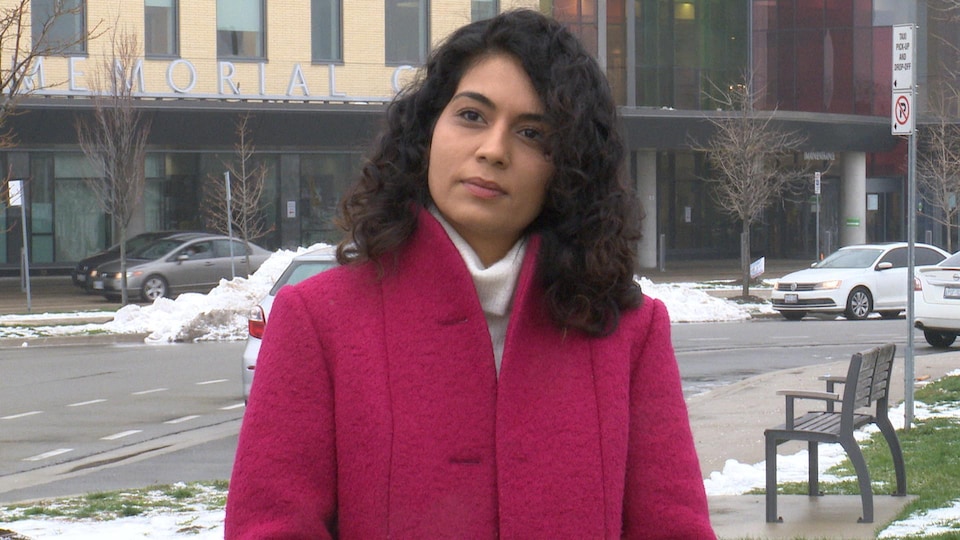The city of Brampton, located in the Region of Peel, is a prime example of what is known as “hallway medicine”.
A single hospital serves this city of about 600,000 inhabitants which is growing rapidly and whose population continues to grow. By comparison, Quebec City, which has a population similar to Brampton, has eight hospitals.
With the pandemic, where are we supposed to send people if the hospital is full?
, asks Jamie-Lee Ball, who grew up and lives in Brampton.
Brampton Civic Hospital. View of the parking lot near the emergency room.
Photo: Radio-Canada / Colin Côté-Paulette
—
In 2017, Jamie-Lee Ball went to the emergency room with severe abdominal pain, as she was experiencing symptoms of internal bleeding.
During the five days she was in the hospital, staff never managed to find her a bed. She suffered on a stretcher, in the middle of the crowd.
She describes this moment as one of the worst sufferings
that she has endured in her life.
A few years later, the health services offer is similar in Brampton.
This is alarming, because the issues of 2017 have not been resolved. It’s even worse because of the pandemic
, says Ms. Ball.
Epicenter of the pandemic
Brampton has become one of the Canadian cities with the highest rate of transmission of COVID-19.
There are several reasons for this situation, Brampton counts:
- many essential workers, such as truck drivers
- Canada’s largest Amazon fulfillment center
Not to mention the particular demographics of the city, which has residents from diverse cultural communities in which intergenerational households are common.
In short, the pandemic has increased the pressure on an already overloaded health system.
In the fall, Peel Public Health announced it had to transfer patients to other areas due to lack of space due to COVID-19.
This is not a new problem
, says Brampton Mayor Patrick Brown straight away.
The politician has made this issue his hobbyhorse for his city.
In January, the city council declared a state of health emergency, even before the pandemic, due to the lack of beds in the region.

Patrick Brown, the Mayor of Brampton.
Photo: Radio-Canada / Colin Côté-Paulette
—
Patrick Brown has since blasted the provincial government for the state of the Brampton hospital system.
Honestly, it’s a failure of all provincial political parties
, says the former leader of the Progressive Conservative Party of Ontario.
We are an underfunded region in terms of health
, souligne M. Brown.
In a document from the municipality (New window), we can read that the number of hospital beds in the region is less than half of the provincial average.
No population of this size has so little investment in health
, summarizes Patrick Brown.

The city of Brampton is one of these growing communities.
Photo: Radio-Canada / Colin Côté-Paulette
—
Capacity issues that persist
Over the years, several reports have shown that the emergency department at Brampton Hospital is operating at full capacity for several months each year.
It is one of the busiest emergency units in Ontario.
According to a CBC News survey (New window), thousands of patients were treated in the corridors of the Brampton Civic Hospital in 2016 and 2017 for lack of space.
For NDP MP Sara Singh, who was born and raised in Brampton, governments come and go without significant investments to address this issue.
This is very worrying, because our community is growing rapidly, without health services following
, believes the member for Brampton Center.

Sara Singh is the NDP MP for Brampton Center.
Photo: Radio-Canada / Colin Côté-Paulette
—
Ms. Singh even says that she got into politics mainly because of the lack of health services in her region.
We need real investments. We have had enough of empty government promises
, she says.
Investments will improve
The Ontario Ministry of Health says the Brampton region should benefit from an updated funding allocation for hospitals located in developing areas.
The ministry spokesperson added, however, that to date, no proposal for a new hospital in Brampton has been submitted for consideration.
Only two hospitals but also other infrastructures
It should be noted, however, that the region of Peel has a few urgent care centers.
In recent years there has been one in Brampton. However, the services one can receive there are limited; the center closes its doors in the evening and has no beds.
In the absence of a second hospital, local elected officials would at least like to see investments in the urgent care center.
The other hospital in the Region of Peel is located in Mississauga and is part of the Trillium Health Partners.
—


